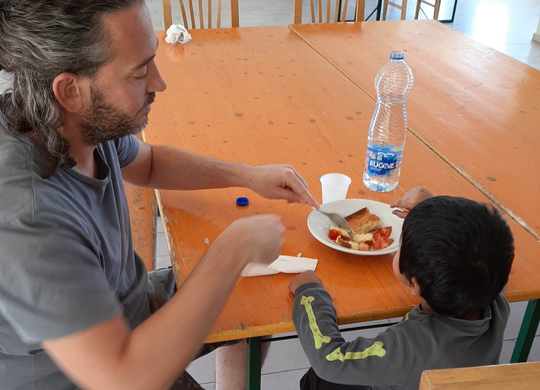Volunteering in Kosovo, Michele’s Story
"It was a long journey before arriving, about 250 km from Tirana. We followed a continuous mountainous landscape along the brand-new A1 motorway that connects the city of Durres to the boarder with Kosovo.
We meet Massimo, the person who runs the family home and the Cooperative in Leskoc. He tells us that previously it would have taken about 14 hours for the same journey. We arrive at the boarder…Everything is fine, we just say “Caritas Italia!” - and the journey continues. It is a beautiful day; a strangely warm and bright sun accentuates the intense green of the landscape.
We immediately realize that we have met a “Great Man”. Massimo, with his infinite calm and almost imperceptible voice, is an inexhaustible font of information. Eager to “know” the situation, we storm him with questions that he never stops answering. Indeed, he almost seems to take pleasure in telling us the minute details. The big picture is starting to become confused. I no longer perceive the outlines and colors that become increasingly blurred. How can so many different scenarios co-exist here in Kosovo? The colors of the sunset mix with the blue background of the sky and accompany us for the last few kilometers.
We arrive at dusk. An imposing U-shaped structure stands before us. On the patio, an extremely well-kept garden provides a sense of freshness. Two teenagers, Arian and Ardit, welcome us in perfect Italian. There is a huge hall with bay windows at the entrance.
It is time for dinner and we get to meet everyone. The family is large! The “smallest” are the first to come forward and make first contact.We also meet Cristina, Massimo’s wife, who works hard to manage a difficult project with him. I can’t fail to notice the cleanliness and order. Long halls, recreation room, mini-apartments, and a tower where the girls have their rooms form the skeleton of the structure. There is a milk processing lab and a bakery in the basement. There is a soccer field and a basketball court adjacent to the structure.
But is this what I expected to find? Why was I wondering if it was “too much” or if it was right? “Too much” compared to what? Why shouldn’t it be right? Why can I have something “beautiful” in Italy, but not in Kosovo? These were my questions that first night.
The following morning the sun radiated from the plateau and the surrounding mountains completed the picture. It was almost like a postcard. There were cornfields ready to be harvested and newly plowed fields to be sown. A wave of positive energy runs through my body!
Breakfast is ready! I am amazed at how everyone contributes to putting everything back in order as soon as they finish eating. From the youngest to the oldest, there are no exceptions! Everyone does their work without complaining. Soon everything is in order and as clean as before. And we’re off! We finish up a few last things and we’re off to school.
The mirage vanishes when we go to deliver food to the less fortunate families with Massimo. We have the opportunity to enter people’s homes and notice the absence of services such as heating and running water; how they all sleep together in a single room without beds, heated by a wood stove; the lack of hygiene; and, in some cases, how people with mental problems are marginalized by society, and don’t receive any help from the state.
Can beauty help to “heal”? Can lights and colors contribute to the process and influence a person’s spirit? I realize how even a serene, beautiful, and clean environment can contribute to the psychophysical well-being of children who have experienced such strong traumas and, in some cases, still experience serious discomfort. “Beauty”, as in doing “beautiful things” for oneself and for others, is part of the process of self-realization and admission to society. It helps us plant a new seed and make sure the plant continues to grow luxuriantly over time.
Thank you, Massimo and Cristina, for the unconditional love you show and for reestablishing a “nest” and dignity to everyone!"
You can also support the project A barn for Leskoc House.
Thanks to your support, the House’s young people will have the opportunity for a real job and liberation. Donate now
LEARN MORE ABOUT THE PROJECT


